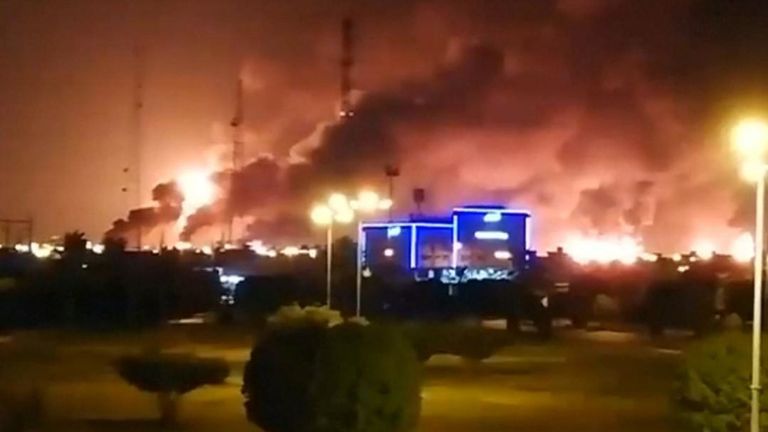An attack on Saudi Arabia that triggered the biggest jump in oil prices in almost 30 years was carried out with Iranian weapons, a Saudi-led coalition says, as President Donald Trump said Washington is “locked and loaded” to hit back.
The Iran-aligned Houthi group that controls Yemen’s capital claimed responsibility for the attack, which knocked out more than half of Saudi Arabia’s oil production and damaged the world’s biggest crude processing plant.
Iran denied US accusations it was to blame and said it was ready for “full-fledged war”.
Two sources briefed on state oil company Saudi Aramco’s operations told Reuters it might take months for Saudi oil production to return to normal. Earlier estimates had suggested it could take weeks.
A Saudi-led military alliance battling the Houthis said the attack on Saudi oil plants was done with Iranian weapons and was not launched from Yemen, according to preliminary findings.
Coalition spokesman Colonel Turki al-Malki said an investigation into Saturday’s strikes, which shut 5 per cent of world crude output, was going on to determine the launch location.
“The preliminary results show that the weapons are Iranian and we are currently working to determine the location … The terrorist attack did not originate from Yemen as the Houthi militia claimed,” Malki told a press conference in Riyadh.
UN Yemen envoy Martin Griffiths told the Security Council on Monday it was “not entirely clear” who was behind the strike but he said it had increased the chances of a regional conflict.
But US ambassador to the world body Kelly Craft told the Council that emerging information on the attacks “indicates that responsibility lies with Iran” and that there is no evidence the attack came from Yemen.
Iran has dismissed as “unacceptable” US accusations that Tehran was responsible.
Oil prices surged by as much as 19 per cent before coming off their peaks. The intraday jump was the biggest since the 1990-91 Gulf crisis over Iraq’s invasion of Kuwait.
Prices eased after Trump announced that he would release US emergency supplies and producers said there were enough stocks stored up worldwide to make up for the shortfall. But traders still spoke of a long-term price increase as markets absorb the proof that global supply can be so sharply hit.
“There is reason to believe that we know the culprit, are locked and loaded depending on verification, but are waiting to hear from the Kingdom as to who they believe was the cause of this attack, and under what terms we would proceed!” Trump said on Twitter on Sunday.
US Energy Secretary Rick Perry pinned the blame squarely on Iran for “an attack on the global economy and the global energy market”.
“The United States wholeheartedly condemns Iran’s attack on Saudi Arabia and we call on other nations to do the same,” he said in a speech at an annual meeting in Vienna of the UN nuclear watchdog IAEA. He added that he was confident the oil market “is resilient and will respond positively”.
Iran has denied blame for the attacks but its Yemeni allies have promised more strikes to come. Houthi military spokesman Yahya Sarea said the group carried out Saturday’s pre-dawn attack with drones, including some powered by jet engines.
US officials say they believe that the attacks came from the opposite direction, possibly from Iran itself rather than Yemen, and may have involved cruise missiles. Wherever the attacks were launched, however, they believe Iran is to blame.
However, Iran has denied a role in specific attacks, including bombings of tankers in the Gulf and previous strikes claimed by the Houthis.
Russia and China said it was wrong to jump to conclusions about who was to blame for the attack on Saudi Arabia.
Britain – Washington’s close ally but wary of its hardline Iran policy – stopped short of ascribing blame but described the assault as a “wanton violation of international law”.
9 news
